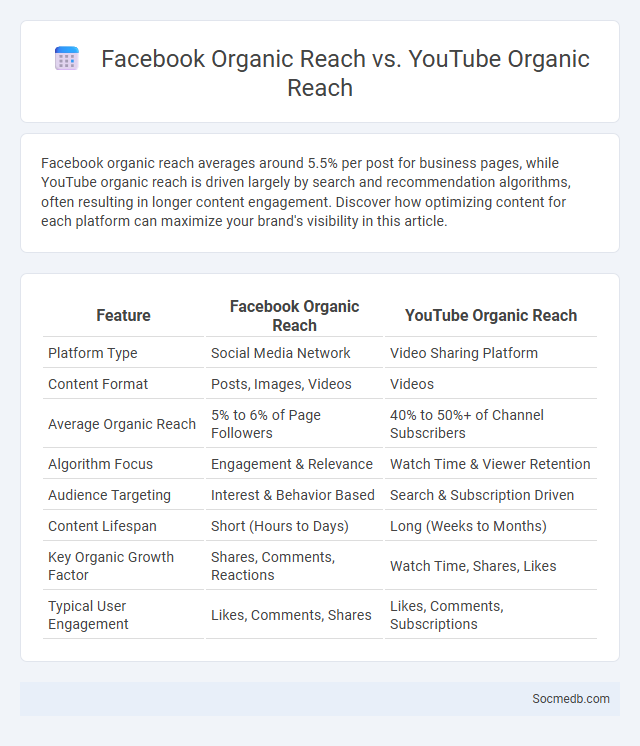
Photo illustration: Facebook Organic Reach vs YouTube Organic Reach
Facebook organic reach averages around 5.5% per post for business pages, while YouTube organic reach is driven largely by search and recommendation algorithms, often resulting in longer content engagement. Discover how optimizing content for each platform can maximize your brand's visibility in this article.
Table of Comparison
| Feature | Facebook Organic Reach | YouTube Organic Reach |
|---|---|---|
| Platform Type | Social Media Network | Video Sharing Platform |
| Content Format | Posts, Images, Videos | Videos |
| Average Organic Reach | 5% to 6% of Page Followers | 40% to 50%+ of Channel Subscribers |
| Algorithm Focus | Engagement & Relevance | Watch Time & Viewer Retention |
| Audience Targeting | Interest & Behavior Based | Search & Subscription Driven |
| Content Lifespan | Short (Hours to Days) | Long (Weeks to Months) |
| Key Organic Growth Factor | Shares, Comments, Reactions | Watch Time, Shares, Likes |
| Typical User Engagement | Likes, Comments, Shares | Likes, Comments, Subscriptions |
Understanding Organic Reach: Definition and Importance
Organic reach on social media refers to the number of unique users who see content without paid promotion, reflecting genuine audience engagement and brand visibility. Understanding organic reach is crucial for optimizing content strategies, as it helps measure the effectiveness of posts in connecting with the target audience naturally. Enhanced organic reach boosts brand authenticity, encourages community building, and reduces reliance on advertising budgets for sustained growth.
Facebook Organic Reach: How It Works
Facebook organic reach refers to the number of unique users who see your content without paid promotion. Algorithms prioritize content based on user engagement, relevance, and interactions within your network, affecting how widely your posts are distributed. To increase your organic reach, your Facebook content should be engaging, timely, and aligned with your audience's interests to maximize visibility in their feeds.
YouTube Organic Reach: Key Mechanisms
YouTube organic reach primarily depends on the platform's recommendation algorithm, which prioritizes viewer engagement metrics such as watch time, likes, comments, and shares. High-quality content that aligns with audience interests and incorporates relevant keywords and tags improves visibility in search results and suggested videos. Consistent posting and leveraging community features like polls and premieres further enhance organic reach by fostering active viewer interaction and retention.
Key Differences: Facebook vs YouTube Organic Reach
Facebook's organic reach primarily depends on its News Feed algorithm, which prioritizes content based on user engagement, relevancy, and relationships, often limiting visibility to a small percentage of page followers. YouTube's organic reach centers around video discovery through search, suggested videos, and subscription feeds, relying heavily on video SEO, watch time, and viewer retention metrics to boost visibility. While Facebook favors frequent, varied content to maintain engagement, YouTube emphasizes high-quality videos optimized for search and algorithmic recommendations to maximize organic reach.
Algorithm Influences on Organic Reach
Social media algorithms prioritize content based on user engagement, relevance, and personalized preferences, significantly impacting organic reach. Posts with higher interaction rates such as likes, comments, and shares are favored, leading to enhanced visibility on platforms like Facebook, Instagram, and Twitter. Understanding these algorithmic factors allows content creators to optimize posting times, use targeted hashtags, and engage audiences effectively to boost natural discovery without paid promotion.
Content Types That Boost Organic Reach on Both Platforms
Video content, including short-form videos and live streams, consistently drives higher engagement and organic reach on both Facebook and Instagram. Carousel posts and image galleries attract user interaction by offering multiple pieces of content in a single post, increasing time spent on the platform. User-generated content and authentic stories enhance trust and visibility, encouraging shares and comments that boost algorithmic ranking.
Engagement Metrics: Facebook vs YouTube
Engagement metrics on Facebook and YouTube differ significantly, with Facebook prioritizing likes, shares, comments, and post reach, while YouTube emphasizes watch time, likes, comments, and subscriber growth. Your content's success on Facebook is often measured by community interaction and viral potential, whereas YouTube focuses on viewer retention and video performance analytics. Understanding these platform-specific engagement metrics helps optimize your social media strategy for better audience connection.
Challenges in Achieving Higher Organic Reach
Algorithms continuously limit your organic reach on social media platforms by prioritizing paid content and user engagement metrics, making it challenging to appear on followers' feeds organically. The constant changes in platform policies and content formats require you to adapt quickly, making consistent visibility difficult to maintain. Competition from an increasing volume of content and advertisers further dilutes the chances of your posts reaching a broader audience without investment.
Strategies to Improve Organic Reach on Facebook and YouTube
Maximize your organic reach on Facebook and YouTube by consistently posting high-quality, engaging content tailored to your target audience's interests and behaviors. Utilize platform-specific features such as Facebook Groups and YouTube Shorts to boost visibility and encourage community interaction. Optimize video titles, descriptions, and tags with relevant keywords to enhance discoverability through search algorithms and increase your YouTube channel's growth.
Future Trends in Organic Reach Across Social Platforms
Future trends in organic reach across social platforms are increasingly influenced by algorithmic changes prioritizing authentic engagement and personalized content delivery. Video formats like short-form clips and live streams continue to dominate, driving higher interaction rates and deeper audience connections. Social networks are integrating AI-powered tools to optimize content visibility, enabling brands to refine targeting strategies and enhance organic performance.
 socmedb.com
socmedb.com